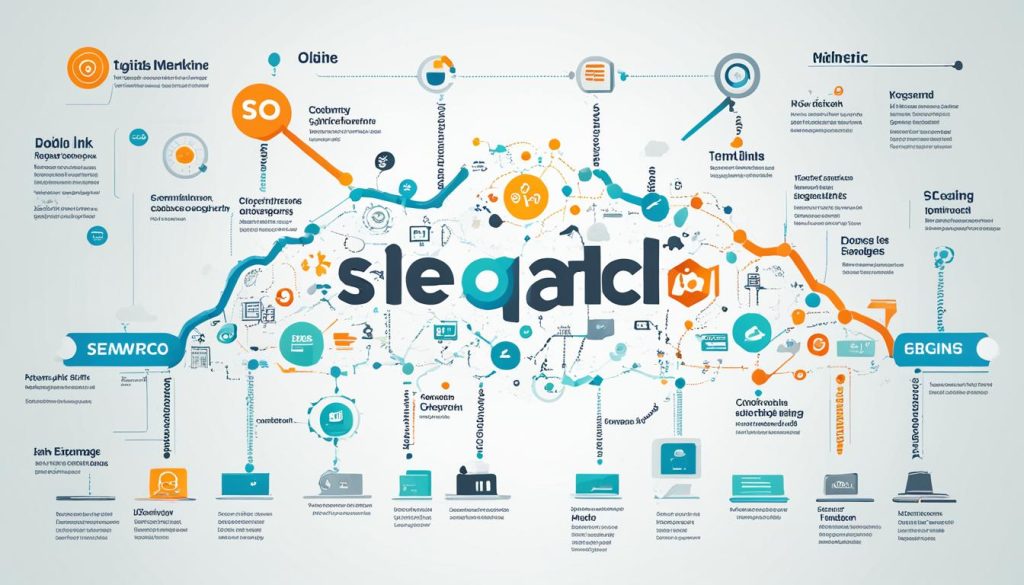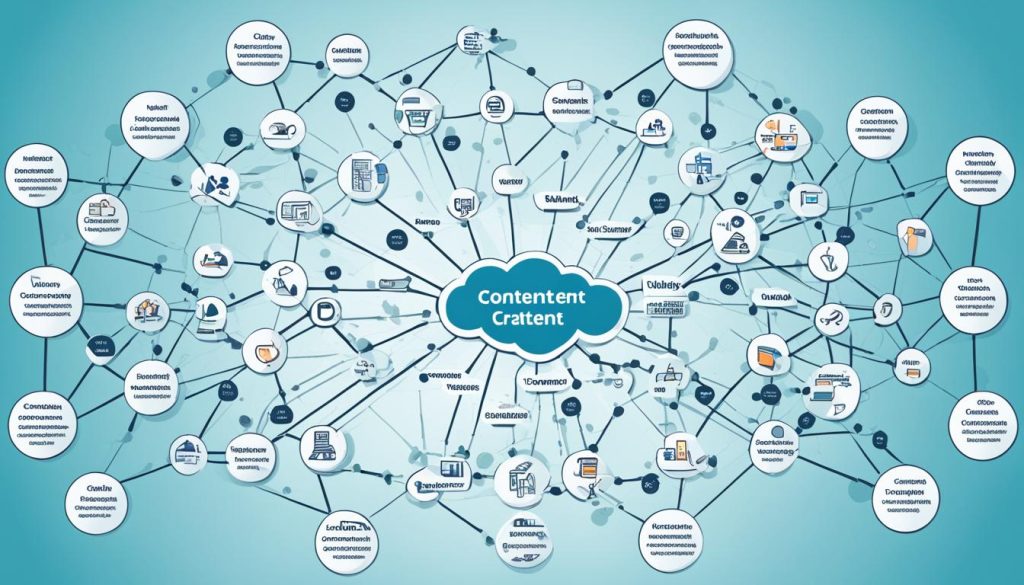The digital world is changing. Now, semantic search optimization is leading the charge for a new SEO strategy. It understands what users really want and pushes sites to the top, boosting their views and search rankings. So, say hello to ‘SEO 2.0’ – a world where context is everything, and staying relevant is key.
Embracing the Evolution of SEO Strategy

In the world of digital marketing, staying ahead is key. The landscape is always changing, especially with search engine optimization (SEO). Companies are now focusing on smarter, long-lasting approaches. Semantic SEO is becoming vital for boosting online presence.
Semantic SEO is a big leap forward in SEO strategy. It focuses on the relevance of content and what users really need. This method fits well with how people search online today. It’s about giving value and engaging users more effectively.
Businesses using cutting-edge SEO can meet their audience’s expectations better. The approach now combines content with user intent. It includes thorough keyword research and creating content that truly engages users. This increases user satisfaction and keeps them coming back for more.
Adopting these cutting-edge SEO methods ensures a business stays competitive. It keeps websites up-to-date as search algorithms change. For companies wanting to lead, keeping up with these SEO trends is crucial. It helps them stay visible and relevant online.
- Advanced Semantic SEO as a keystone of today’s digital marketing strategies.
- Thorough keyword research and content optimization for user-oriented results.
- Enhanced user engagement as a yardstick for SEO and business success.
Meeting both user needs and search engine rules requires hard work and smart strategies. As digital marketing evolves, so must our SEO strategies. For those ready to innovate, the future looks promising. SEO innovation brings endless possibilities for growth.
Understanding Semantic SEO’s Foundation
In digital marketing, things are shifting to focus more on the user. Semantic SEO is key in this change. It looks at what users really want and how to understand them better. We’re going to look at what makes Semantic SEO important and how it improves how visible websites are online.
How Semantic Search Enhances User Experience
Semantic search is about more than just moving up search engine ranks. It aims to make searching online smoother for users. By responding to natural-sounding questions, it gives users the exact answers they want. So, by considering the whole context and not just keywords, users get the information they really need.
The Role of Natural Language Processing in SEO
Natural Language Processing (NLP) is changing how search engines work with online content. It uses smart algorithms to grasp human languages. So, NLP improves how search engines understand search queries. This makes finding answers online feel more natural for users.
The Significance of Search Intent for Online Visibility
Understanding what users are looking for is crucial for being seen online. Semantic SEO focuses on making content that meets users’ actual needs. This does not just attract users but also shows search engines your site is relevant. It makes your website easier to find, adding to its presence on the internet.
Comprehensive Content Creation Techniques

In Semantic SEO, success comes from content that dives deep and covers many topics. This creates in-depth content. Picture your site as a beacon of knowledge. Every page adds to a network of information. This method builds content clusters, showing your expertise in a niche. It helps in authority building. Your site becomes a top source for users and search engines.
- Start your strategy by picking main topics your audience likes. Then, outline related subtopics to form a cluster.
- Make sure every content piece is valuable. Do this through thorough research and sharing facts, figures, and insights.
- Link these clusters with a story, taking readers on a learning journey.
- Regularly check and update your content to keep it fresh and relevant as trends change.
Your content clusters enhance user experience and tell search engines your site has important, meaningful content. This is key for good search rankings. By linking in-depth content and related materials, your site shows its control over a topic. This builds audience trust and credibility.
- Start with a main article that covers your cluster’s big theme.
- Add articles that go into specific details, studies, or viewpoints related to the main topic.
- Connect the articles in the cluster to lead readers to more content. This boosts their engagement and learning.
Starting this journey makes your website more than a place for info. It becomes a trusted advisor. Crafting detailed content networks helps your audience understand deeply. This increases your visibility. Step by step, your website becomes an authority in its field. This status is crucial for growth in the UK and the world.
Structured Data Markup and Its SEO Benefits

The digital world is getting more complex. Using structured data has become key for better search engine understanding. This organised format makes it easier for search engines to understand content. It also helps websites get rich snippets, making them more visible in search results.
Now, let’s look at the benefits of adding structured data to your website:
- Enhanced Search Engine Comprehension: Structured data presents information in a way that’s easy for search engines to understand. This means they get a clear picture of what your site is about.
- Opportunities for Rich Snippets: With structured data, your web pages could get rich snippets. These are the boxes that show up in search results. They grab user attention and can lead to more clicks.
- Improved Relevance in Search Listings: Structured data makes it clear how your content relates to search queries. This can mean better positions in search engine results pages (SERPs).
Structured data improves how your website talks to search engines. It acts like an advanced SEO tool that boosts visibility and attracts more interested users. By using this markup, any brand can grow its online presence and do better in today’s digital world.
Conversational Language: A Crucial Element in Semantic SEO

In the world of Semantic SEO, using conversational language is essential. It’s not just a trend. It’s about making content more engaging and relevant in searches. Moving away from hard-to-understand terms to everyday language matches how search engines operate today. This change is good for users and helps businesses get noticed more online.
It makes online content more relatable, easier to digest, and more appealing. This leads to a better experience on websites. It also improves content’s chances in voice search results, which often sound more like natural conversations.
Search engines now favor content that’s easy to use and helpful. By adopting a conversational style, websites signal their value to search engines. This boosts their position in search results.
- Facilitates a deeper connection with the audience through relatable and digestible content.
- Encourages longer user interaction times by creating an intuitive and comfortable website experience.
- Improves the chances of content ranking for voice search queries which often utilise conversational phrasing.
As engines have become more advanced, they reward user-friendly content. Having a conversational tone shows search engines your content is useful. This helps place your site higher in search results (SERPs).
- Analyse common queries in your niche to understand the conversational language patterns of your target audience.
- Adapt content to include these patterns, enhancing both the relatability and search relevance of your website.
- Monitor user engagement as an indicator of how effectively your content is meeting the conversational needs of your users.
The future of SEO is focusing more on humans. Conversational language makes content more engaging and relatable. It helps secure a leading spot in the digital world.
Optimising for Mobile and Enhancing UX

Today, mobile optimisation is key for great SEO. Websites must perform well on mobile to rank high in search engines. This shows they offer a top-notch user experience. Having a mobile-friendly site is a must, as more people use smartphones and tablets to go online.
To optimise your site for mobile, focus on a few areas. First, your site must load quickly on mobile to keep visitors. Fast loading time boosts user happiness and is important for search rankings. Also, having a responsive design is vital. It makes sure your site works well on various devices and screens. Lastly, your site should be easy to use on touch screens, with elements that are simple to tap.
- Implement responsive design to ensure that your website adjusts fluidly across different devices.
- Minimise load times by optimising images and leveraging browser caching.
- Utilise user-friendly navigation that enhances usability and encourages longer site visits.
- Make sure all buttons and links are easy to tap to improve the mobile interactive experience.
- Regularly test your mobile website performance across various devices and operating systems to ensure consistent quality.
A site not optimised for mobile can lose a big mobile audience and fall in search rankings. Focusing on mobile optimisation, user experience, and website performance can push your SEO forward. By focusing on these, you meet both user needs and search engine criteria. This helps your site stand out and grow organically in a competitive digital world.
How to Use Semantic SEO

Semantic SEO brings a deeper insight into content optimisation. It looks beyond mere words to their meanings and what users really want. This approach helps connect with your audience in a smarter, more intutive manner.
Identifying Semantic Patterns and User Behaviour
Analysing how users interact with search engines reveals valuable patterns. It’s about knowing user intent, not just guessing. By understanding these interactions, content can be tailored more effectively to user needs.
- User interactions analysis for tailoring content
- Identifying trends to pinpoint user needs
- Developing content strategies based on search behaviours
Integrating Related Terms and Synonyms
Using synonyms and related terms is key to reaching more people. It allows your content to cover a wider range of searches. This strategy makes sure your website meets user queries more accurately.
- Expanding reach with synonym inclusion
- Enriching content with semantic variants
- Refining the semantic footprint of your website
Utilising Contextual Signals for Content Relevance
Knowing the context of user searches is crucial. This insight helps ensure that your content truly meets user needs. Using this method improves your content’s value and relevance dramatically.
- Leveraging search context to inform content creation
- Implementing content matching for deeper user connection
- Utilising semantic search signals to guide content development
Mastering Semantic SEO means your website not only meets current needs but also anticipates future questions. This establishes your site as a relevant and authoritative source in the digital realm.
Keyword Research in the World of Semantic Search

SEO changes constantly. With semantic search now important, marketers must understand intent-based keyword research. Making content match user search intent is key to good search engine rankings.
Semantic search looks at the semantic search keywords people use for specific target queries. It’s not just about keyword volume. Semantic SEO focuses on the context of words to improve search accuracy for user intent.
- Identifying the deeper layers of search context to reveal the true user intent behind queries
- Expanding research to include long-tail keywords that capture conversational queries
- Analyzing patterns in search behaviour to adapt content strategy for better semantic relevance
Adopting a strong intent-based keyword research strategy is vital for keeping up. It involves understanding the purpose behind search terms, not just listing popular terms.
Semantic search changes how we create content. Focusing on semantic search keywords lets us align content with what users seek. This increases the chance of our content solving their queries.
- Examine data from search engines to determine the questions and needs of users
- Construct a comprehensive keyword plan that focuses on these information-seeking target queries
- Utilise tools that aid in uncovering semantically relevant keywords and phrases
Understanding queries and providing answers is key, not just guessing keywords. With semantic search strategies, your content meets the goals of your audience. This builds meaningful connections and drives genuine traffic to your site.
Content Optimisation for Semantic Accuracy

The world of search engine optimisation is now valuing topic-related content more than just keywords. This change means we focus on creating content that covers topics fully, aiming to completely meet user needs. It’s not only about writing articles; it’s about making content that is both informative and engaging for the reader.
Writing for Topics, Not Just Keywords
When we focus on what users are really looking for, we look beyond just keywords. We dig deep into topics to build rich sources of information. These resources aim to answer questions and solve problems for our readers. This approach helps us connect better with our audience, aligning closely with what they are searching for.
Creating Content Clusters for Enhanced Understanding
Organising articles into content clusters makes information easier for people to find. These clusters link together related topics, helping search engines better understand and categorise our content. It helps users and search engines alike get a clearer picture of what our content offers.
- Cluster topics based on user interests and frequently searched terms.
- Interlink related articles to enhance topic relevancy and domain authority.
- Address user concerns comprehensively within each cluster to establish expertise.
This strategy of building content clusters doesn’t just make the website better for users. It also strengthens how search engines view our content by making semantic links clearer. This leads to a web that is more intuitive and focused on learning, matching how people search and study online today.
Employing Semantic Markup for Search Engine Clarity

The smart use of semantic markup is key for clear search engine messages. Standards like those from Schema.org are crucial in the coding of websites. They help search engines understand and display webpage content better.
Using semantic markup is like giving a map to search engines. It helps them to read content more accurately. This improves search results for users and supports voice searches and instant answers.
- Understanding Schema.org and Its Benefits for SEO
- Steps for Implementing Semantic Markup on Your Website
- Testing and Validating Markup for Optimal Performance
By using Schema.org data, webmasters can make HTML more descriptive and smart. This outlines the purpose behind the content. It also makes it easier for search algorithms to index the site.
Adding semantic markup needs careful attention, but it has big rewards. It leads to better search features like snippets, graphs, and listings. This offers an edge in the online world.
- Drive engagement with visually enriched search results.
- Highlight the core information and services your website offers.
- Enhance content discoverability and accuracy in search responses.
These efforts all aim at one SEO goal: to stand out and be understood easily on search engines. Adopting semantic markup is essential, not just for the tech-savvy. It’s a key part of modern SEO.
Exploiting Semantic Keyword Research
SEO is now more about understanding the context than just adding keywords. It has moved towards context-driven SEO. This change means we need to focus on different types of keywords, including variant keyword exploration and semantic long-tail keywords. This piece explains how a detailed search strategy and smart keyword analysis can boost your presence online.
Exploring Variants, Synonyms, and Long-tail Phrases
Reaching a wider audience requires focusing on variant keywords. These are synonyms and long-tail phrases that people might search for. By doing this, you can better understand your industry’s semantic space. This makes your content easier to find and more relevant.
Here are ways to effectively include these strategies:
- Turn basic keywords into phrases that mimic real-life conversations and questions.
- Use tools for semantic keyword variants to find out what variations your audience searches for.
- Create content that naturally uses these variants, answering a wider range of questions.
Assessing Search Context and Intent Strategically
Knowing what your audience really wants to find is crucial in SEO. Effective user intent assessment makes your content meet your audience’s needs better. Here’s how to strategically look at search context and intent:
- Look at the types of searches bringing people to your site. They could be informational, navigational, transactional, or commercial.
- Build a user intent assessment framework. This helps classify keywords and shape your content right.
- Use feedback to keep improving your content as user behavior and preferences change.
With a smart approach to keyword research, your SEO work can bring better results. This keeps you ahead in the competitive digital world.
Maximising User Experience to Complement Semantic SEO
The digital world is changing fast. Combining great user experience with Semantic SEO is now more important than ever. It’s vital to make your site welcoming and engaging. This way, visitors will stay longer, and search engines will notice your site’s value.
Improving Site Navigation for User Retention
To encourage users to stay, your site must be easy to explore. A well-organized layout with clear directions helps users find what they need quickly. This leads to more time spent on your site and better user retention. Features like a simple menu, breadcrumbs, and a clear structure make browsing smooth. This enhances user engagement and satisfaction.
- Audit your current navigation structure and identify areas for improvement.
- Implement drop-down menus or mega menus for complex sites with multiple categories.
- Ensure that your search functionality is prominent and yields accurate results.
Improving navigation is about more than looks. It shapes how users move from arrival to action. This tells search engines your content is valuable.
Loading Speeds and Mobile Responsiveness
In today’s world, websites must load quickly and work well on phones. Fast load times and a design that works on any device keep users happy. This is crucial for keeping people engaged and boosting your site’s SEO. A design that’s easy to use on all devices can make users much happier.
- Compress images and leverage lazy-loading to accelerate page performance.
- Minimize HTTP requests and reduce server response times.
- Adopt responsive web design to create a seamless experience on any screen size.
A pleasant online experience shows you’re trustworthy and professional. It also tells search engines your site is of high quality. This is key for doing well in Semantic SEO.
By focusing on these areas, you meet search algorithms’ technical needs and cater to your users. This creates a perfect space for today’s digital users.
Strategic Semantic Link Building
Link building is key for SEO, but it must change as search engines do. It focuses on getting backlinks related to your content. It’s not just about lots of links. Each one should come from a site important to your field. These links are more than just traffic routes; they show trust and relevance online.
Getting authoritative links requires patience and care. They bring visitors and show search engines your site is credible. As you get more, they boost your site’s SEO. This careful link building is vital for improving your online position and visibility.
Semantic SEO improvement is about more than just having many links. It makes your content more relevant, helping your site signal to search engines. This supports search engines’ aim to find the best content for queries. By linking with context, you reach more searches. This strategic link-building strengthens your online presence with quality and clear purpose.
FAQ
Q: What is Semantic SEO and how does it differ from traditional SEO?
Q: How does Semantic Search enhance user experience?
Q: What role does Natural Language Processing play in SEO?
Q: Why is understanding search intent fundamental for online visibility?
Q: How can comprehensive content creation techniques improve my SEO?
Q: What are the SEO benefits of Structured Data Markup?
Q: Why is conversational language important in Semantic SEO?
Q: How does mobile optimisation enhance user experience (UX)?
Q: What strategies are included in using Semantic SEO?
Q: How does keyword research change with Semantic Search?
Q: Why should I write for topics, not just keywords?
Q: What is the advantage of employing Semantic Markup?
Q: How is Semantic Keyword Research conducted?
Q: Why is maximising user experience crucial for Semantic SEO?
Q: How does link building work with Semantic SEO?
Source Links
- https://iloveseo.com/content-marketing/content-optimization/mastering-the-art-of-intent-how-semantic-search-transforms-your-seo-strategy/
- https://community.hubspot.com/t5/HubSpot-Ideas/Unlocking-the-Secrets-of-Semantic-SEO-Revolutionizing-Content/idi-p/956189
- https://www.linkedin.com/pulse/unveiling-power-semantic-seo-step-by-step-guide-boosting-chauhan-pg6te?trk=article-ssr-frontend-pulse_more-articles_related-content-card
